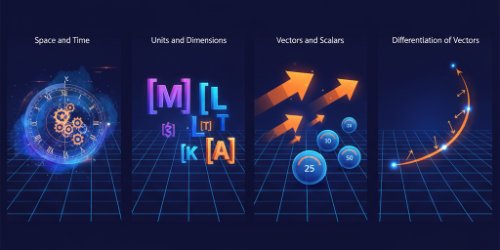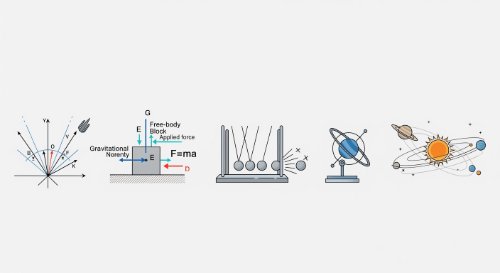Welcome - Introduction | Introduction to Physics (Undergraduate Foundation)
SPONSORED Get Personalized Tutoring NowStruggling with a tough concept or looking to advance your skills? Our expert tutors offer one-to-one guidance tailored to your unique needs.
Get instant support, clear explanations, and practical strategies to master even the most challenging subjects. With flexible scheduling and customized learning plans, success is just a session away.
Book your personalized tutoring today and start achieving your academic goals!
Get Personalized Tutoring NowStruggling with a tough concept or looking to advance your skills? Our expert tutors offer one-to-one guidance tailored to your unique needs.
Get instant support, clear explanations, and practical strategies to master even the most challenging subjects. With flexible scheduling and customized learning plans, success is just a session away.
Book your personalized tutoring today and start achieving your academic goals!
Struggling with a tough concept or looking to advance your skills? Our expert tutors offer one-to-one guidance tailored to your unique needs. Get instant support, clear explanations, and practical strategies to master even the most challenging subjects. With flexible scheduling and customized learning plans, success is just a session away. Book your personalized tutoring today and start achieving your academic goals!
 Introduction to Physics (Undergraduate Foundation)Physics is not a collection of facts; it is a quantitative language. This course establishes that language. We cover the formal system of measurement and units, the rigorous method of dimensional analysis, the complete framework of vector algebra, and the use of calculus to describe how vector quantities change. This is the essential grammar of science.
The tools in this course have immediate, practical applications. Correct dimensional analysis is a critical technique for verifying equations and preventing catastrophic errors in any technical calculation. Vectors are the required language for describing forces, displacements, velocities, and fields in any engineering or scientific discipline. Mastering this material is the first step to becoming a competent technical professional.
Upon completion, you will command the mathematical toolkit for physics. You will perform dimensional analysis to validate equations. You will resolve vectors into components, calculate vector sums and products, and differentiate vector functions to analyse rates of change, such as deriving velocity from a position vector.
This course is the mandatory starting point for first-year university students of engineering, physics, computer science, and related disciplines. A firm command of secondary school algebra, geometry, and trigonometry is a prerequisite. It is also suitable for professionals who require a rigorous and efficient refresher on the foundational mathematical tools of science.
Introduction to Physics (Undergraduate Foundation)Physics is not a collection of facts; it is a quantitative language. This course establishes that language. We cover the formal system of measurement and units, the rigorous method of dimensional analysis, the complete framework of vector algebra, and the use of calculus to describe how vector quantities change. This is the essential grammar of science.
The tools in this course have immediate, practical applications. Correct dimensional analysis is a critical technique for verifying equations and preventing catastrophic errors in any technical calculation. Vectors are the required language for describing forces, displacements, velocities, and fields in any engineering or scientific discipline. Mastering this material is the first step to becoming a competent technical professional.
Upon completion, you will command the mathematical toolkit for physics. You will perform dimensional analysis to validate equations. You will resolve vectors into components, calculate vector sums and products, and differentiate vector functions to analyse rates of change, such as deriving velocity from a position vector.
This course is the mandatory starting point for first-year university students of engineering, physics, computer science, and related disciplines. A firm command of secondary school algebra, geometry, and trigonometry is a prerequisite. It is also suitable for professionals who require a rigorous and efficient refresher on the foundational mathematical tools of science.
Physics is not a collection of facts; it is a quantitative language. This course establishes that language. We cover the formal system of measurement and units, the rigorous method of dimensional analysis, the complete framework of vector algebra, and the use of calculus to describe how vector quantities change. This is the essential grammar of science. The tools in this course have immediate, practical applications. Correct dimensional analysis is a critical technique for verifying equations and preventing catastrophic errors in any technical calculation. Vectors are the required language for describing forces, displacements, velocities, and fields in any engineering or scientific discipline. Mastering this material is the first step to becoming a competent technical professional. Upon completion, you will command the mathematical toolkit for physics. You will perform dimensional analysis to validate equations. You will resolve vectors into components, calculate vector sums and products, and differentiate vector functions to analyse rates of change, such as deriving velocity from a position vector. This course is the mandatory starting point for first-year university students of engineering, physics, computer science, and related disciplines. A firm command of secondary school algebra, geometry, and trigonometry is a prerequisite. It is also suitable for professionals who require a rigorous and efficient refresher on the foundational mathematical tools of science.
 PHY 101: General Physics I - MechanicsThis learning track provides a complete and rigorous treatment of introductory classical mechanics as specified by the NUC Core Curriculum. It is structured to build a comprehensive analytical framework, starting with the mathematical description of motion (kinematics) and progressing through its causes (Newtonian dynamics), the powerful conservation laws, the dynamics of rotating systems, and finally, the principles of universal gravitation. Mastery of this material is the non-negotiable foundation for all subsequent study in physics and engineering.
The principles of classical mechanics are the operational language for analysing the physical world. This track provides the essential toolset for solving problems in every field of engineering, from aerospace to civil, and for understanding phenomena from the trajectory of a projectile to the orbits of planets. By the end of this track, you will be able to analyse motion using vectors and calculus, apply Newton's laws to solve any standard dynamics problem, use conservation laws to analyse complex systems and collisions, analyse rotational motion, and solve problems in celestial mechanics.
This learning track is a mandatory prerequisite for all first-year university students of physics, engineering, and related physical sciences. It provides the foundational knowledge required for all subsequent courses in mechanics, electromagnetism, thermodynamics, and modern physics.
PHY 101: General Physics I - MechanicsThis learning track provides a complete and rigorous treatment of introductory classical mechanics as specified by the NUC Core Curriculum. It is structured to build a comprehensive analytical framework, starting with the mathematical description of motion (kinematics) and progressing through its causes (Newtonian dynamics), the powerful conservation laws, the dynamics of rotating systems, and finally, the principles of universal gravitation. Mastery of this material is the non-negotiable foundation for all subsequent study in physics and engineering.
The principles of classical mechanics are the operational language for analysing the physical world. This track provides the essential toolset for solving problems in every field of engineering, from aerospace to civil, and for understanding phenomena from the trajectory of a projectile to the orbits of planets. By the end of this track, you will be able to analyse motion using vectors and calculus, apply Newton's laws to solve any standard dynamics problem, use conservation laws to analyse complex systems and collisions, analyse rotational motion, and solve problems in celestial mechanics.
This learning track is a mandatory prerequisite for all first-year university students of physics, engineering, and related physical sciences. It provides the foundational knowledge required for all subsequent courses in mechanics, electromagnetism, thermodynamics, and modern physics.
This learning track provides a complete and rigorous treatment of introductory classical mechanics as specified by the NUC Core Curriculum. It is structured to build a comprehensive analytical framework, starting with the mathematical description of motion (kinematics) and progressing through its causes (Newtonian dynamics), the powerful conservation laws, the dynamics of rotating systems, and finally, the principles of universal gravitation. Mastery of this material is the non-negotiable foundation for all subsequent study in physics and engineering. The principles of classical mechanics are the operational language for analysing the physical world. This track provides the essential toolset for solving problems in every field of engineering, from aerospace to civil, and for understanding phenomena from the trajectory of a projectile to the orbits of planets. By the end of this track, you will be able to analyse motion using vectors and calculus, apply Newton's laws to solve any standard dynamics problem, use conservation laws to analyse complex systems and collisions, analyse rotational motion, and solve problems in celestial mechanics. This learning track is a mandatory prerequisite for all first-year university students of physics, engineering, and related physical sciences. It provides the foundational knowledge required for all subsequent courses in mechanics, electromagnetism, thermodynamics, and modern physics.